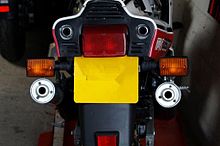
A two-strokeengine is a type of internal combustion engine that completes a power cycle with two strokes of the piston during one power cycle, this power cycle being completed in one revolution of the crankshaft. A four-stroke engine requires four strokes of the piston to complete a power cycle during two crankshaft revolutions. In a two-stroke engine, the end of the combustion stroke and the beginning of the compression stroke happen simultaneously, with the intake and exhaust functions occurring at the same time.
Yamaha Motor Co., Ltd. is a Japanese multinational manufacturer of motorcycles, marine products such as boats and outboard motors, and other motorized products. The company was established in 1955 upon separation from Yamaha Corporation, and is headquartered in Iwata, Shizuoka, Japan. The company conducts development, production and marketing operations through 109 consolidated subsidiaries as of 2012.

The Honda CX series motorcycles, including the GL500 and GL650 Silver Wing variants, were developed and released by Honda in the late 1970s, with production ending in most markets by the mid 1980s. The design included innovative features and technologies that were uncommon or unused at the time such as liquid cooling, electric-only starting, low-maintenance shaft drive, modular wheels, and dual CV-type carburetors that were tuned for reduced emissions. The electronic ignition system was separate from the rest of the electrical system, but the motorcycle could only be started via the start button.
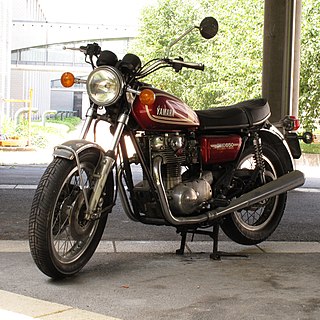
The Yamaha XS650 is a mid-size motorcycle made by Yamaha Motor Company. The standard model was introduced in October 1969,and produced through 1979. The "Special" cruiser model was introduced in 1978 and produced through 1985. The XS650 began with the 1955 Hosk SOHC 500 twin. After about 10 years of producing 500 twin, Hosk engineers designed a 650 cc twin. Later the Hosk company was acquired by Showa Corporation, and in 1960 Yamaha had bought Showa with Hosk's early design of 650 cc twin.
The two-stroke power valve system is an improvement to a conventional two-stroke engine that gives a high power output over a wider RPM range.
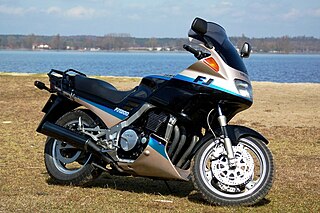
The Yamaha FJ1100 and FJ1200 are sport touring motorcycles that were produced by Yamaha between 1984 and 1996.

A motorcycle engine is an engine that powers a motorcycle. Motorcycle engines are typically two-stroke or four-stroke internal combustion engines, but other engine types, such as Wankels and electric motors, have been used.

The Yamaha RZ350 is a two-stroke motorcycle produced by Japanese motorcycle manufacturer Yamaha between 1983 and 1996. Available in the US from 1983-1985, Canada until 1990 and Brazil until 1996. The RZ was the final evolution of the popular and well-known series of RD Yamaha motorcycles, and as such is also known as the RD350LC II or RD350 YPVS.

The Suzuki GSX-R750 is a sports motorcycle made by Suzuki since 1985. It was introduced at the Cologne Motorcycle Show in October 1984 as a motorcycle of the GSX-R series.

The Yamaha Blaster is a compact all-terrain vehicle produced as an entry-level machine manufactured in Japan and sold in the United States from 1988 to 2006. Because of the Blaster's initial low price tag, it sold in large numbers for many years from its inception in 1988 all the way to present day. Enthusiasts are still buying and building Blasters that compete with modern day four-strokes. Its two-stroke engine is easily modified and a large aftermarket now exists for the quad. A range of add-ons are readily available from simple bolt on modifications and suspension parts to complete aftermarket frames and big bore kits to give more power to the engine.
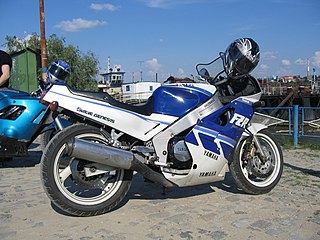
The Yamaha FZR1000 is a motorcycle produced by Yamaha from 1987 to 1995. Classed as a sports motorcycle.

The L-twin is a naturally aspirated two-cylinder petrol engine by Ducati. It uses a 90-degree layout and 180-degree firing order as is mounted with one cylinder horizontal.
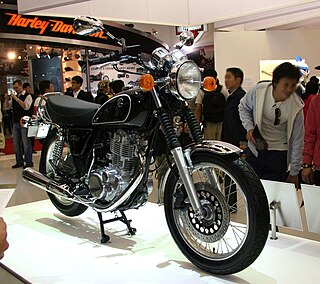
The Yamaha SR400 (1978–2021) and SR500 (1978–1999) are single-cylinder, air-cooled, two-passenger motorcycles manufactured in Japan by Yamaha Motor Company as a street version of the Yamaha XT500, with a standard riding posture and styling resembling the Universal Japanese Motorcycles of the 1970s. The two models differ by their engines: the SR400 engine has a lower displacement, achieved with a different crankshaft and shorter piston stroke and both models feature only kickstarting, i.e., no electric starter.

The Yamaha FZ750 is a sports motorcycle produced by Yamaha Motor Corporation between 1985 and 1991. The FZ750 is notable for several reasons, perhaps the most radical being the 5-valve cylinder head with a radial arrangement. This became something of a Yamaha trademark. The FZ750 would be the first bike in the Genesis design concept.

The TX750 is a two-cylinder standard motorcycle built by Yamaha. The bike was released in 1972. Significant reliability problems affected the engines in early bikes. Yamaha made several changes to solve the problems but the bike was withdrawn from most markets after 1974 and production stopped in the home market after 1975.
The Yamaha TZR125 is a two-stroke 125 cc (7.6 cu in) sports motorcycle made for the European and South East Asian markets which uses the YPVS. The TZR125 was produced from 1987 and spanned two generations until the late 1990s each with a number of variants and sub variants.

The Yamaha RD350LC was a two-stroke motorcycle produced by Yamaha between 1980 and 1983.

The Kawasaki A1 Samurai is a 250 cc (15 cu in) standard class Kawasaki motorcycle which was sold from 1967 through 1971.

Yamaha RD350 YPVS is a motorcycle that Yamaha made from 1983 to 1986. It was launched at the Cologne motorcycle show as "the nearest thing to a road going racer ever produced".

The Yamaha TZ 250 was a commercially available racing motorcycle with a watercooled, two-stroke, 250 cc engine produced by the Japanese manufacturer Yamaha.


